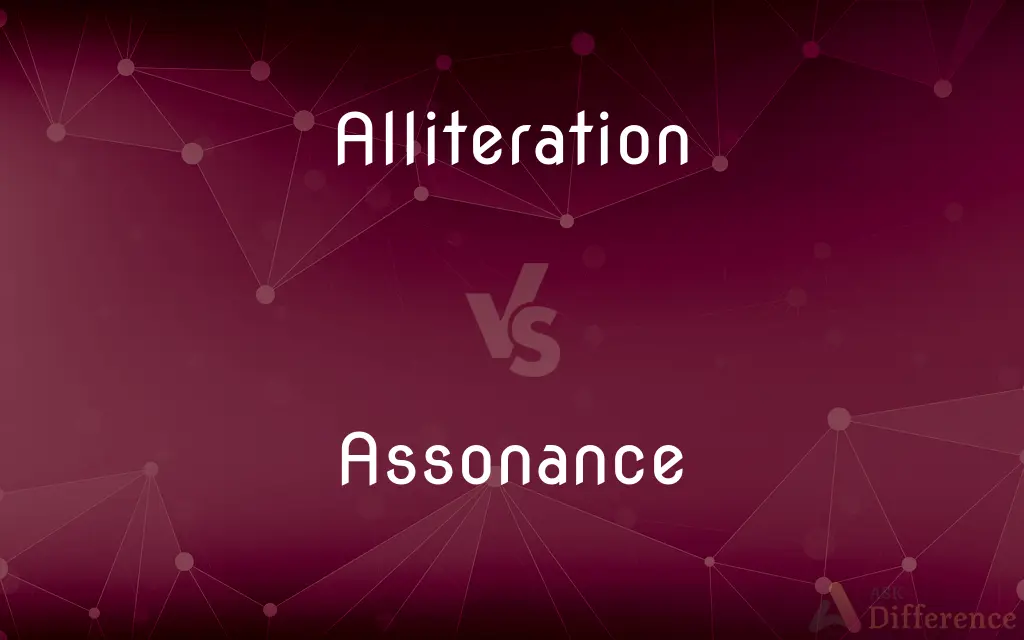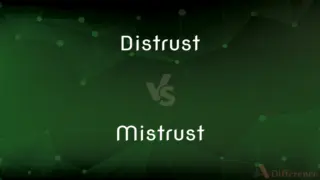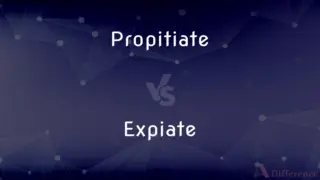Alliteration vs. Assonance — What's the Difference?
Edited by Tayyaba Rehman — By Fiza Rafique — Updated on September 25, 2023
Alliteration involves the repetition of initial consonant sounds in words close to each other in a sentence. Assonance is the repetition of vowel sounds in words that are close to each other but start with different consonants.

Difference Between Alliteration and Assonance
Table of Contents
ADVERTISEMENT
Key Differences
Alliteration is a stylistic device commonly used in poetry and prose where the initial consonant sounds in words are repeated. For instance, "Peter Piper picked a peck of pickled peppers" showcases alliteration in the repeated "p" sounds. This device is often used for emphasis or to create a rhythm within the text.
Assonance, on the other hand, is another stylistic device that involves the repetition of vowel sounds in nearby words. Unlike alliteration, the words do not have to start with the same consonant. An example would be, "The rain in Spain stays mainly in the plain," where the 'ai' sound is repeated. Assonance is typically used to create a mood or tone within a text.
Both alliteration and assonance are tools that poets and writers use to add musical elements to their work. Alliteration usually focuses on the beginning of the word, lending a rhythmic beat to the text. Assonance, however, can occur anywhere in the words and contributes more to the mood or the internal emotional atmosphere of the work.
It's important to note that alliteration generally impacts the text's flow and tempo, making it sound more melodious. Assonance affects the tone and atmosphere, often imbuing the text with a certain emotional nuance. While both can be used in various forms of writing, they are particularly prominent in poetry due to their rhythmic and mood-enhancing qualities.
Comparison Chart
Type of Sound
Consonant sounds
Vowel sounds
ADVERTISEMENT
Position in Words
Beginning
Anywhere
Common Usage
Poetry, Prose
Mainly in Poetry
Impact
Rhythm, Melody
Mood, Atmosphere
Example
"Peter Piper picked..."
"The rain in Spain..."
Compare with Definitions
Alliteration
A stylistic device used for emphasis.
Big, blue butterflies.
Assonance
Occurs frequently in poetry.
I lie down by the side of my bride.
Alliteration
Repetition of initial consonant sounds in words.
She sells sea shells.
Assonance
Used to set the mood or tone.
The light of the fire is a sight.
Alliteration
Commonly used in tongue twisters.
How much wood would a woodchuck chuck.)
Assonance
Repetition of vowel sounds in words.
Go and mow the lawn.
Alliteration
Creates a rhythmic pattern in text.
Mighty mountains making music.
Assonance
Can appear anywhere in the word.
Hear the mellow wedding bells.
Alliteration
In literature, alliteration is the conspicuous repetition of identical initial consonant sounds in successive or closely associated syllables within a group of words, even those spelled differently. As a method of linking words for effect, alliteration is also called head rhyme or initial rhyme.
Assonance
Assonance is a resemblance in the sounds of words/syllables either between their vowels (e.g., meat, bean) or between their consonants (e.g., keep, cape). However, assonance between consonants is generally called consonance in American usage.
Alliteration
The occurrence of the same letter or sound at the beginning of adjacent or closely connected words
The alliteration of ‘sweet birds sang’
Alliterations are clustered in the last few lines
Assonance
Resemblance of sound between syllables of nearby words, arising particularly from the rhyming of two or more stressed vowels, but not consonants (e.g. sonnet, porridge), but also from the use of identical consonants with different vowels (e.g. killed, cold, culled)
Alliterative assonances such as ‘fail’ and ‘fall’ are very common in Old English poetry
The use of assonance throughout the poem creates the sound of despair
Alliteration
The repetition of identical or similar sounds at the beginning of words or in stressed syllables, as in "on scrolls of silver snowy sentences" (Hart Crane). Modern alliteration is predominantly consonantal; certain literary traditions, such as Old English verse, also alliterate using vowel sounds.
Assonance
Resemblance of sound, especially of the vowel sounds in words, as in
"that dolphin-torn, that gong-tormented sea" (William Butler Yeats).
Alliteration
The repetition of consonant sounds at the beginning of two or more words immediately succeeding each other, or at short intervals.
Assonance
The repetition of identical or similar vowel sounds, especially in stressed syllables, with changes in the intervening consonants, as in the phrase tilting at windmills.
Alliteration
The recurrence of the same letter in accented parts of words, as in Anglo-Saxon alliterative meter.
Assonance
Rough similarity; approximate agreement.
Alliteration
The repetition of the same letter at the beginning of two or more words immediately succeeding each other, or at short intervals; as in the following lines: -
Behemoth, biggest born of earth, upheavedHis vastness.
Fly o'er waste fens and windy fields.
In a somer seson whan soft was the sonne,I shope me in shroudes as I a shepe were.
Assonance
(prosody) The repetition of similar or identical vowel sounds (though with different consonants), usually in literature or poetry.
Alliteration
Use of the same consonant at the beginning of each stressed syllable in a line of verse;
Around the rock the ragged rascal ran
Assonance
Resemblance of sound.
Alliteration
Often found in brand names for memorability.
Coca-Cola.
Assonance
A peculiar species of rhyme, in which the last accented vowel and those which follow it in one word correspond in sound with the vowels of another word, while the consonants of the two words are unlike in sound; as, calamo and platano, baby and chary.
The assonance is peculiar to the Spaniard.
Assonance
Incomplete correspondence.
Assonance between facts seemingly remote.
Assonance
The repetition of similar vowels in the stressed syllables of successive words
Assonance
Enhances the emotional atmosphere.
The crumbling thunder of seas.
Common Curiosities
What is alliteration?
Alliteration is the repetition of initial consonant sounds in closely situated words.
Can alliteration and assonance appear together?
Yes, both can be used together for different effects in a text.
Is assonance primarily a poetic device?
Assonance is mostly found in poetry but can appear in prose as well.
Is alliteration more common in poetry?
While common in poetry, alliteration also appears in prose and even everyday speech.
Is alliteration easy to spot?
Alliteration is usually easier to spot because it involves the first letter of the words.
Do alliterated words have to be consecutive?
No, alliterated words can be separated but are usually close to each other in the text.
What does assonance add to poetry?
Assonance often adds mood or emotional atmosphere to poetry.
What is assonance?
Assonance is the repetition of vowel sounds in closely situated words.
What mood does assonance generally create?
Assonance can create various moods depending on the vowel sounds and context.
Does assonance focus on the start of the word?
No, assonance can occur anywhere within the word.
Why is alliteration used in brand names?
Alliteration makes brand names easier to remember.
Can alliteration be unintentional?
Yes, alliteration can occur naturally in everyday speech.
Are there rules for alliteration?
There are no strict rules, but the repeated sounds should be close enough to be noticeable.
Can assonance and alliteration occur in the same word?
Yes, a single word can contain both if it repeats both consonant and vowel sounds.
Does assonance have to involve rhyme?
No, assonance is independent of rhyme.
Share Your Discovery

Previous Comparison
Distrust vs. Mistrust
Next Comparison
Propitiate vs. ExpiateAuthor Spotlight
Written by
Fiza RafiqueFiza Rafique is a skilled content writer at AskDifference.com, where she meticulously refines and enhances written pieces. Drawing from her vast editorial expertise, Fiza ensures clarity, accuracy, and precision in every article. Passionate about language, she continually seeks to elevate the quality of content for readers worldwide.
Edited by
Tayyaba RehmanTayyaba Rehman is a distinguished writer, currently serving as a primary contributor to askdifference.com. As a researcher in semantics and etymology, Tayyaba's passion for the complexity of languages and their distinctions has found a perfect home on the platform. Tayyaba delves into the intricacies of language, distinguishing between commonly confused words and phrases, thereby providing clarity for readers worldwide.














































